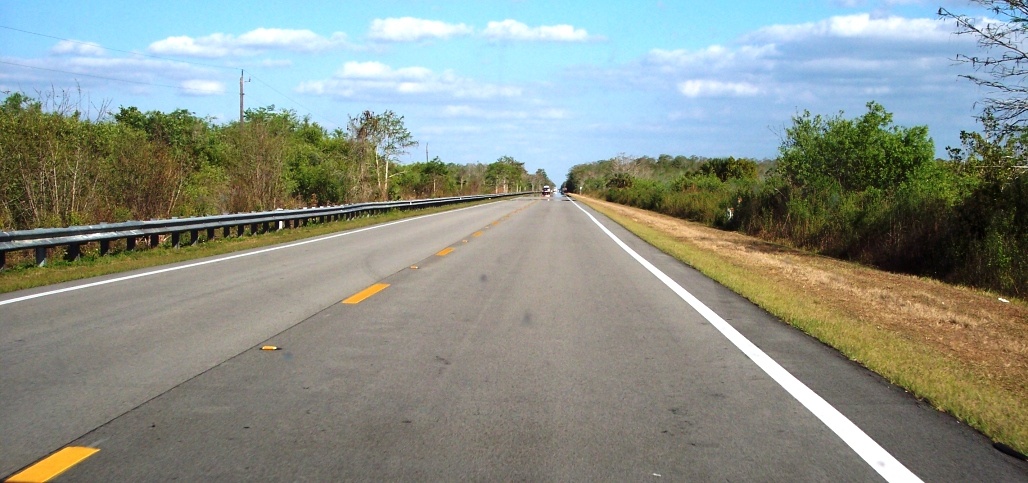The 2020 book, RECONOMICS: The Path To Resilient Prosperity, made the following observation: “80% of the revitalizing work done by urban planners and civil engineers in the 21st century will undo 80% of the work done by their predecessors in the 20th century.”
In southern Florida back in 1928, the U.S. Army Corps of Engineers finished one of their proudest achievements: they built a road that dammed the vital water flows of the Everglades, doing more to kill this vast, precious ecosystem than any other single project. The Tamiami Trail was the southernmost 275 miles (443 km) of U.S. Highway 41 (US 41), which runs from Florida State Road 60 (SR 60) in Tampa to US 1 in Miami.
The road passed through one of the most wildlife-rich areas of the planet, provided no animal crossings whatsoever, so it also became one of the most efficient wildlife-killing machines ever invented: a murderous mechanism that continued running for almost a century. When another, wider cross-Florida highway was later built—also bearing the name Tamiami Trail—(nicknamed Alligator Alley) the original Tamiami Trail became known as the Old Tamiami Trail.
Now, on August 3, 2021, the Corps of Engineers completed another proud achievement: removing a six-mile stretch of the Old Tamiami Trail. Part of the $20 billion Everglades Restoration Project, the Old Tamiami Trail Roadbed Removal Project was finished six months ahead of schedule.
“Audubon is celebrating today the righting of an ecological wrong. The Tamiami Trail has long stood as an impediment to water flowing into Everglades National Park,” said Julie Wraithmell, Executive Director of Audubon Florida. “With the completion of this project, connectivity and water flow are much improved, to support the imperiled habitats and species that need it most. We applaud the SFWMD and DOT for completing this project ahead of schedule and Governor DeSantis for making this important work such a priority.”
This project is a critical Everglades restoration project to remove nearly six miles of roadbed from the Old Tamiami Trail, allowing more water to naturally flow south into Everglades National Park.
“Our administration has been focused on restoring the Everglades for generations of Floridians to enjoy,” said Lieutenant Governor Jeanette Nunez. “As a South Floridian, I am proud that we have all come together to recognize how important this is, and I look forward to working with the Water Management District, DEP, FWC and all of our partners to continue completing these projects at a record pace.”
In March of this 2021, the groundbreaking of the project was announced, and it was then which was expected to be completed in January 2022.
This crucial project is a component of the larger Central Everglades Planning Project (CEPP), which also includes the Everglades Agricultural Area (EAA) Reservoir Project.
“Because of the partnerships represented today, we were able to complete this project early and are one step closer to moving water from our conservation areas to Everglades National Park and ultimately to Florida Bay,” said FWC Chairman Rodney Barreto.
CEPP will help deliver additional clean water from Lake Okeechobee south to Water Conservation Area 3, Everglades National Park and Florida Bay.
“Sending more clean water south is essential to furthering Everglades restoration and protecting the St. Lucie and Caloosahatchee estuaries from harmful discharges,” said Governor Ron DeSantis. “Since day one, my administration has been focused on expediting key Everglades restoration and water quality projects to protect Florida’s natural resources for future generations, and I’m proud of our record-setting progress.”
By removing the roadbed, the project helps restore the ecologically important sheet flow of water south through the Everglades.
“Removing the Old Tamiami Trail roadbed is a critical step in helping us restore the flow of freshwater south into the Everglades and Florida Bay,” said Eric Eikenberg, President of The Everglades Foundation. “For a long time, Florida held a lot more ground-breakings than ribbon-cuttings. But, under the leadership of Governor Ron DeSantis and the South Florida Water Management District, we have been celebrating project completions that are making a real difference in our environment and our clean water economy.”
The roadbed removal is expected to increase the flow of clean freshwater into the Northeast Shark River Slough area of the park by more than 220 billion gallons per year.
“Today marks another milestone in the state’s efforts to accelerate restoration of the South Florida ecosystem and deliver long overdue benefits to Floridians throughout the region. The Tamiami Roadbed Removal Project will improve water quality, support sending more water south and reduce harmful estuary discharges,” said DEP Interim Secretary Shawn Hamilton.
The Tamiami Trail Projects, EAA Reservoir Project and other critical Everglades restoration projects were identified by Governor DeSantis in his Achieving More Now For Florida’s Environment Executive Order to be expedited and completed as quickly as possible. The state began construction of the EAA Reservoir Project Stormwater Treatment Area 12 months ahead of schedule.
Photo by Adbar (via Wikipedia) shows the Old Tamiami Trail seen toward the east in the Big Cypress National Preserve, a few miles north of the Everglades National Park.

